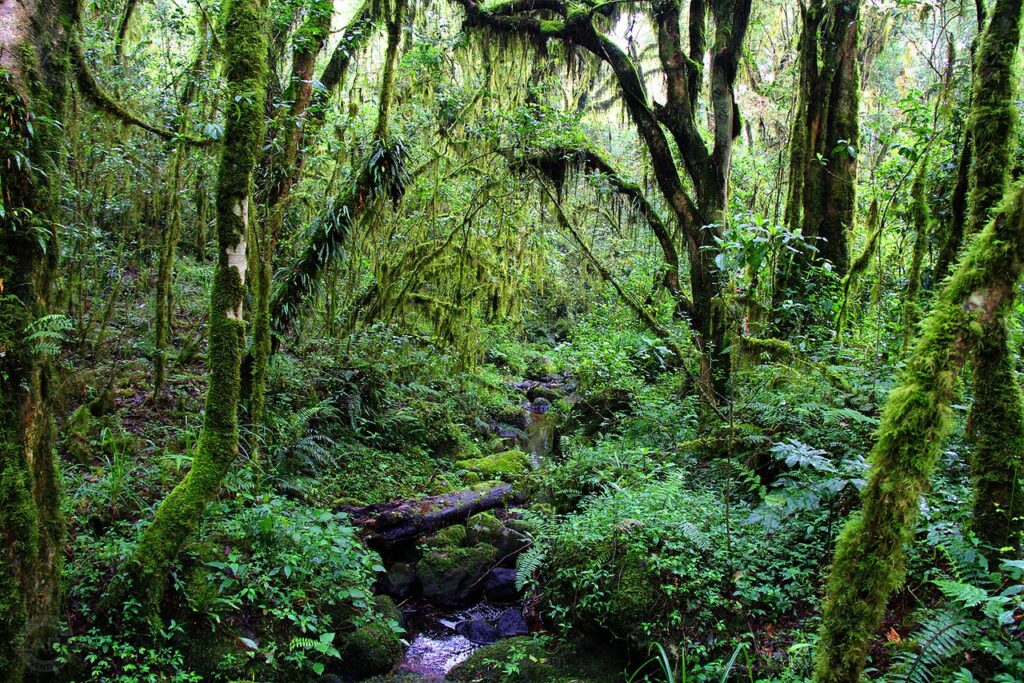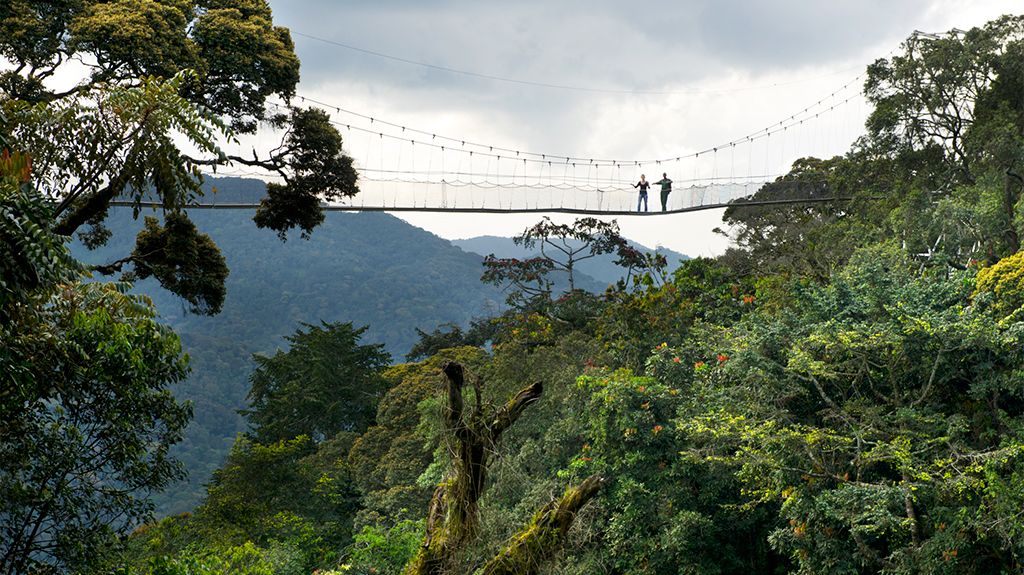Mount Kilimanjaro, Africa’s highest peak at 5,895 meters (19,341 feet), is more than just a climber’s paradise—it’s a living testament to nature’s diversity and resilience. Rising majestically from the Tanzanian plains, this dormant volcano hosts an extraordinary range of ecosystems, making it a global hotspot for Kilimanjaro ecology. This comprehensive guide, crafted by Africa Paradise Adventures, explores the rich biodiversity on Kilimanjaro, from its unique flora and fauna to the vital conservation efforts Mount Kilimanjaro depends on. Whether you’re planning a trek in 2025 or simply curious about this natural wonder, discover why Kilimanjaro’s ecological significance is a journey worth exploring.
The Ecological Zones of Mount Kilimanjaro

Kilimanjaro’s diverse altitudes create a series of distinct ecological zones, each supporting a unique array of life. These zones, spanning from lush rainforests to barren alpine deserts, showcase the mountain’s remarkable Kilimanjaro ecology.
Cultivation Zone (800–1,800 meters)
- Description: The lowest zone, dominated by small farms and villages, where local communities grow coffee, bananas, and maize.
- Flora: Cultivated crops like coffee arabica and fruit trees, alongside native shrubs.
- Fauna: Small mammals like monkeys and birds such as the African paradise flycatcher.
- Significance: Supports human livelihoods while transitioning into wilder ecosystems higher up.
Rainforest Zone (1,800–2,800 meters)
- Description: A dense, humid forest teeming with life, often shrouded in mist, making it a critical part of biodiversity on Kilimanjaro.
- Flora: Towering trees like the East African camphorwood and fig, with epiphytes like orchids and ferns. The endemic Impatiens kilimanjari, a vibrant flower, thrives here.
- Fauna: Colobus monkeys, bushbucks, leopards, and over 120 bird species, including the Hartlaub’s turaco.
- Significance: Acts as a water catchment area, feeding rivers that sustain the region.
Heath and Moorland Zone (2,800–4,000 meters)
- Description: An open landscape of heather and giant lobelias, marking a shift to harsher conditions.
- Flora: Giant groundsels (Senecio kilimanjari) and lobelias (Lobelia deckenii), adapted to cold and wind.
- Fauna: Elusive leopards, rock hyraxes, and birds like the lammergeier vulture.
- Significance: Highlights Kilimanjaro’s ability to support specialized species in challenging environments.
Alpine Desert Zone (4,000–5,000 meters)
- Description: A stark, arid region with minimal vegetation, testing the limits of Kilimanjaro ecology.
- Flora: Sparse cushion plants and lichens, like Helichrysum, designed to survive extreme conditions.
- Fauna: Rare sightings of klipspringers and the occasional bird, such as the alpine chat.
- Significance: Demonstrates the mountain’s resilience and the adaptability of its life forms.
Arctic Summit Zone (5,000–5,895 meters)
- Description: The icy peak, including the Uhuru Peak glacier, where life is nearly absent.
- Flora: Virtually none, with only microscopic organisms surviving.
- Fauna: No permanent wildlife, though birds like the white-necked raven occasionally soar.
- Significance: A stark reminder of climate change’s impact, with glaciers shrinking rapidly.
Biodiversity on Kilimanjaro: Flora and Fauna Highlights
Kilimanjaro’s biodiversity on Kilimanjaro is a treasure trove, shaped by its altitudinal gradient and isolation. Here’s a closer look at its standout species:
Unique Flora
- Impatiens kilimanjari: A striking red and yellow flower endemic to Kilimanjaro’s rainforest, symbolizing the mountain’s botanical richness.
- Giant Groundsels and Lobelias: These towering plants, with their woolly leaves, are iconic adaptations to the moorland zone, protecting against freezing nights.
- Everlasting Flowers (Helichrysum): Drought-resistant plants in the alpine desert, adding color to the barren landscape.
- Orchids and Ferns: Over 160 orchid species and numerous ferns thrive in the rainforest, contributing to its lush canopy.
Fascinating Fauna
- Colobus Monkey: With its black-and-white coat, this arboreal primate is a rainforest resident, often seen in troops.
- Leopard: A elusive predator roaming the forest and moorland, occasionally spotted by trekkers.
- Rock Hyrax: A small, rodent-like mammal adapted to rocky terrains, found up to 4,500 meters.
- Birdlife: Over 179 bird species, including the scarce lammergeier vulture and the colorful Taveta golden weaver, enrich Kilimanjaro’s skies.
Endangered Species and Conservation Focus
- Abbott’s Duiker: A rare antelope found in the rainforest, threatened by habitat loss.
- Kilimanjaro Tree Hyrax: An endemic subspecies vulnerable due to deforestation.
- Glaciers: Once covering 11.4 square kilometers in 1912, they’ve shrunk to less than 1 square kilometer today, a critical conservation concern.
Conservation Efforts Mount Kilimanjaro
Conservation efforts Mount Kilimanjaro are crucial to preserving its ecosystems amid growing threats like climate change, deforestation, and tourism pressure. Here’s how Kilimanjaro is being protected:
Kilimanjaro National Park Management
- Established: 1973, with UNESCO World Heritage status in 1987, recognizing its ecological value.
- Role: The Tanzania National Parks Authority (TANAPA) enforces regulations, including waste management and trail maintenance, to minimize human impact.
- Impact: Protects 75,575 hectares, ensuring habitats for endemic species like the Kilimanjaro tree hyrax.
Reforestation and Habitat Restoration
- Initiatives: Local communities and organizations like the Kilimanjaro Porters Assistance Project (KPAP) plant native trees to restore the rainforest zone.
- Success: Over 100,000 trees planted since 2003, combating deforestation from farming and logging.
- Benefit: Stabilizes soil, enhances water retention, and supports wildlife habitats.
Climate Change Mitigation
- Glacier Monitoring: Research by the University of Innsbruck tracks glacier retreat, informing global climate models.
- Sustainable Tourism: Africa Paradise Adventures promotes eco-friendly treks, reducing carbon footprints with solar-powered camps and waste reduction.
- Impact: Raises awareness and funds for glacier preservation, though complete loss is projected by 2040 without intervention.
Community Involvement
- Maasai and Chagga Partnerships: Local tribes participate in conservation, receiving tourism revenue to protect their land.
- Education Programs: Schools near Kilimanjaro teach students about Kilimanjaro ecology, fostering a conservation mindset.
- Benefit: Empowers communities to sustain biodiversity while supporting their livelihoods.
Trekker Contributions
- KPAP Support: Trekkers with Africa Paradise Adventures can donate to KPAP, ensuring fair wages for porters and funding conservation.
- Leave No Trace: Guidelines encourage trekkers to minimize waste, preserving the mountain’s pristine state.
- Impact: Direct funding and reduced environmental strain support long-term conservation efforts Mount Kilimanjaro.
Threats to Kilimanjaro’s Ecology

Despite conservation strides, Kilimanjaro faces significant challenges:
- Climate Change: Rising temperatures (0.2°C per decade) accelerate glacier melt, threatening water sources and alpine species.
- Deforestation: Illegal logging and farming expansion encroach on the rainforest, reducing habitat for fauna like the Abbott’s duiker.
- Tourism Pressure: Over 50,000 climbers annually increase waste and trail erosion, straining Kilimanjaro ecology.
- Invasive Species: Non-native plants like the Mexican sunflower compete with native flora, disrupting ecosystems.
Planning Your Trek with Ecological Awareness
A trek with Africa Paradise Adventures offers a chance to experience biodiversity on Kilimanjaro while supporting conservation. Here’s how to plan responsibly:
Best Time to Visit
- Dry Season (June–October): Clear skies and optimal wildlife viewing, ideal for observing Kilimanjaro ecology.
- Green Season (November–May): Lush landscapes and fewer crowds, though wetter conditions may limit access. February–March is great for biodiversity studies.
Recommended Routes
- Marangu Route: A 5–6 day trek through rainforests and moorlands, showcasing diverse flora and fauna ($1,800–$2,500 per person).
- Lemosho Route: A 7–8 day scenic journey, highlighting giant groundsels and leopards ($2,500–$3,500 per person).
- Machame Route: A 6–7 day challenging path with rich biodiversity, including orchids ($2,000–$3,000 per person).
Packing Tips
- Eco-Friendly Gear: Use reusable water bottles, biodegradable soap, and lightweight equipment to reduce waste.
- Clothing: Layered, neutral-colored clothing (khaki, olive) to blend with the environment and protect against sun and cold.
- Observation Tools: Binoculars and a camera to document biodiversity on Kilimanjaro without disturbing wildlife.
Health and Safety
- Vaccinations: Ensure yellow fever, typhoid, and hepatitis A shots are up-to-date. Consult your doctor 6–8 weeks before travel.
- Altitude Awareness: Acclimatize with longer routes; guides from Africa Paradise Adventures monitor health.
- Travel Insurance: Include medical evacuation coverage for safety.
Booking with Africa Paradise Adventures
- Customized Treks: Visit africaparadiseadventures.com/book-now to tailor your climb, supporting conservation efforts Mount Kilimanjaro.
- Eco-Certification: Choose operators like Africa Paradise Adventures that follow KPAP standards for sustainable tourism.
- Early Booking: Reserve 6–12 months ahead for peak season (June–October) to secure permits and eco-friendly camps.
Unique Experiences to Explore Kilimanjaro’s Ecology
- Guided Nature Walks: Learn about flora and fauna with expert guides on the Lemosho or Marangu routes.
- Conservation Talks: Attend sessions at base camps to understand Kilimanjaro ecology and ongoing efforts.
- Photography Safaris: Capture endemic species like the Impatiens kilimanjari, contributing to conservation awareness.
- Community Visits: Engage with Chagga farmers to see sustainable agriculture practices.
Frequently Asked Questions (FAQs)
What makes Kilimanjaro’s ecology unique?
Kilimanjaro’s altitudinal zones support diverse flora and fauna, from rainforests to alpine deserts, making Kilimanjaro ecology a global ecological marvel.
How is biodiversity on Kilimanjaro being protected?
Conservation efforts Mount Kilimanjaro include reforestation, climate monitoring, community involvement, and trekker contributions via organizations like KPAP.
Can I see wildlife on a Kilimanjaro trek?
Yes, expect colobus monkeys, leopards, and birds like the lammergeier, especially in the rainforest and moorland zones of biodiversity on Kilimanjaro.
What is the best time to explore Kilimanjaro’s ecology?
June–October offers clear views and optimal wildlife activity, while November–May showcases lush greenery, ideal for ecological studies.
The ecological wonders of Mount Kilimanjaro reveal a world of vibrant Kilimanjaro ecology, from the lush rainforests teeming with biodiversity on Kilimanjaro to the stark alpine deserts shaped by conservation efforts Mount Kilimanjaro. Trekking with Africa Paradise Adventures offers a chance to witness this natural heritage while contributing to its preservation through eco-friendly practices and community support. Whether you’re marveling at giant groundsels, spotting colobus monkeys, or learning about glacier conservation, your journey will deepen your appreciation for this iconic peak. Start planning your 2025 Kilimanjaro adventure today at africaparadiseadventures.com and become part of the effort to protect this ecological treasure!





